BONHILL PAGE 3
PAGE 1 | PAGE 2 | PAGE 4 | PAGE 5
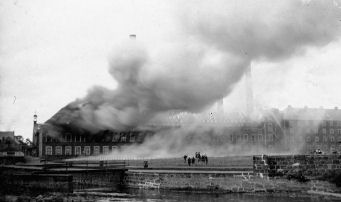
Dillichip Works Fire (Click to Enlarge)
Subsequent Bonhill textile works were neither quite so memorable as Dalmonach, nor as enduring. The next to open was Lang's “Wee Field” or Bonhill Printworks, to give it its proper name. This small factory, which in 1838 employed 100 people, including 58 children, was shoehorned into a corner of land between the Church, the Main Street and the bottom of the Burn, close to the Bottle Linn. It did not last very long but shortly before its closure about 1840, an engraving was made of it and its surroundings. Jones & Hopner in their book On Leven's Banks reckon this engraving was done about 1838, and it is easily the most interesting thing about the Wee Field, as we shall see below.
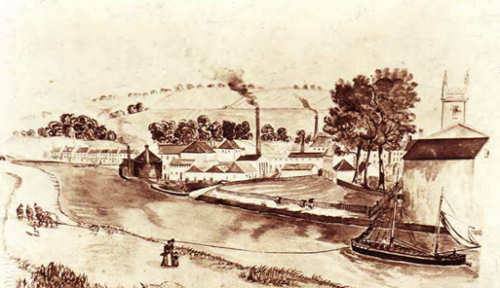
The Factory at the "Wee Field", Bonhill
Another short-lived small factory just off Main Street was Kirkland Printworks. It was in operation between the 1820's and about 1860 when it was bought by Sir Archibald Orr Ewing who thought so highly of it that he had it demolished to make room for his expansion plans for Dillichip Works, which he acquired in 1866. Kirkland's name lives on in the Kirkland Lane housing estate part of which lies close to the site of the old Works.
Dillichip was the fourth of the Bonhill textile factory. Dillichip's opening date is unclear, but it was certainly in operation by the 1820's as a bleachfield. It was bought by Sir Archibald Orr Ewing in 1866, converted to a dyeworks and substantially expanded. In 1875 he even had a branch railway line laid into the Works. It left the main line just south of Alexandria station and crossed the River Leven on its own bridge (the Black Bridge). When the UTR was formed in 1897, Dillichip was the UTR's only works in Bonhill. It closed as a dyeworks in 1936, but many of Orr Ewing's buildings from the 1860's and later have survived through a variety of other uses such as a REME depot during the war, a textile store, and now a bonded warehouse.
Naturally, the village of Bonhill rapidly expanded to accommodate the people who came to work in these factories, and their families. Houses and supporting services such as schools, shops, medical services and churches sprung up in the early years of the 19th century, as the population grew. About 1800, there were about 1,000 people living in houses clustered round the Burn and on the Main Street, and the junction of these two streets remained the centre of Bonhill for nearly two centuries. Most of them would have worked in Dalmonach Works or the Wee Field. There was little to the north or south of this junction at this time.
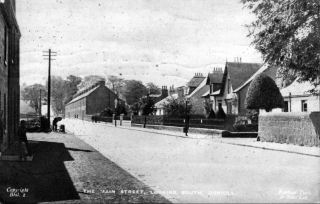
Dillichip Terrace and Main Street Bonhill (Click to Enlarge)
However, by 1841 the Village's population had risen to 2,115 while by 1851 it was about 2,500. There seemed to be plenty of work in Bonhill - for instance in the late 1830's Dillichip was employing about 565 people. In fact, in the 1850's the major problem in the Vale's factories was a lack of capacity rather than a lack of demand, and people were leaving the Vale for other textile finishing areas such as Paisley, not to find work, but to make more money from larger piece work bonuses on more productive processes.
This was the main driver for the rebuilding and expansion boom of the 1850's and 60's, led by Sir Archibald Orr Ewing, which saw factories such as Dillichip and to a lesser extent (because it always more innovative and productive) Dalmonach, take on the appearance of large brick built edifices, some of which survive to this day. The smaller, less efficient factories such as the Wee Field and Kirkland fell by the wayside, but their workforces were immediately absorbed in the modern, redeveloped factories.
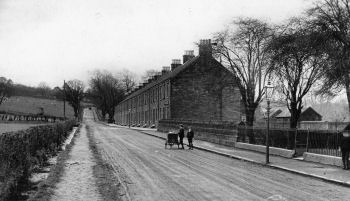
Dillichip Terrace Bonhill (Click to Enlarge)
To begin with, the houses in which people lived tended to be small two storey tenement buildings. The only ones to survive in Bonhill are in Dillichip Terrace (see image above and below), but there are still a few in Main Street Alexandria, and in any case there are plenty of pictures of these old houses, especially beside the Burn - which of course was still open at that time.
Many were built from stone quarried at the end of Burn. The ready supply of the stone as well as that of the water made the Burn a natural place for the early incomers to settle. In time the Burn turned out to be an open sewer as well as the water supply, and epidemics of infectious diseases became quite common.
John Neil in his book Records and Reminiscences of Bonhill Parish tells of a Doctor Humphreys who made his reputation from treating victims of the “first outbreak” of cholera in Bonhill, presumably in the 1830's or 40's. How many more outbreaks there were Neil does not record. However, Graham Lappin in “Old Alexandria, Bonhill & Renton” says that there was a case of typhoid in Campbell Street in 1900, while less serious infectious diseases were not uncommon until the mid 1920's.
It was 1929 before the Burn was covered over, by which time the Glen Finlas Waterworks had been supplying Bonhill and most of the rest of the Vale (not Renton) with just about the best water in the world, for 20 years.
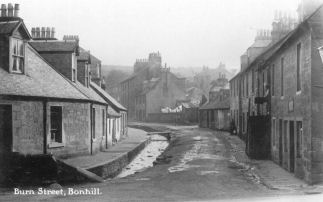
Burn Street Bonhill (Click to Enlarge)
Various small businesses had sprung up to support the population and local industry. In the Burn these included a candle factory (until the coming of gas, which was not in widespread use until the 1880's), a thread mill, a nail works and a blacksmith's shop. A smiddy, owned by Arthur Millar, survived until the 1980's in a single storey building on the south side of Burn Street. It was probably there for over 150 years, since we know that Dalmonach School was built on the site of a smiddy, which was probably moved to the Burn immediately prior to the building of the school about 1830. View Arthur Millar at work in a film at the Scottish Screen archive >
Further up the Burn, at Hillbank, stood a distillery, which burned down in 1827 and which has yet to be rebuilt, though many live in hope. There was also at least one cooperage in Bonhill. Some historians place it in the Burn, while others categorically say that it was in Braehead almost opposite what became Bonhill South Church. Perhaps there were in fact two cooperages. The one in Braehead was owned by the Bryce family and operated till about 1860, and by then most of its output went via Dumbarton Quay to the sugar refineries in Greenock.
Social life was varied from an early stage. In 1817 the Bonhill Instrumental Band was formed, and it was as famous for the rest of the 19th century as Bonhill Pipe Band was in the mid 20th century, when it won the Cowal Championship in 1952. The Instrumental Band, or Bonhill Band as it was known, played on just about every notable public occasion in the Vale and a number further a-field, including the laying of the foundation stone of the Wallace Monument.
It paraded every New Year's Day, led Masonic Funerals to the Churchyards in Alexandria and Bonhill, and played the Vale FC home from the railway station whenever they won the Scottish Cup, so that kept it busy. It appears in many photographs of the Freeing of the Bridges and the opening of the new Bonhill Bridge when it led the parade on both occasions. The Band survived well into the 20th century.
Religion played a prominent part in people's lives. In 1831, 4 years before the present Bonhill Parish Church was built in 1835-6, a different brand of Presbyterianism - the Relief Church - had built its new church on a hill overlooking the north end of the village. This Church eventually became Bonhill North Church, but is best remembered as Mount Zion. Initially it was accessed via another of Bonhill's and the Vale's best known streets, the illustrious Cannon Row, or as it was originally known, Church Row.
Mount Zion closed in the 1970's and stood derelict into the early 1980's when it was demolished and replaced by a private house. In the early 1830's, however, its building was a significant extension northwards for Bonhill. At the time and for many years later, only Dalmonach Works, School and House and the Church lay north of the ferry crossing.
The Disruption in the Church of Scotland in 1843 resulted in a third church being built in Bonhill - the Free Church, which was built in 1847 on the west side of main Street at the top of the brae in the appropriately named Braehead. After the churches were re-united in 1929, it became Bonhill South, but is probably best remembered as Alan Hasson's church after its charismatic, if eccentric, minister of the 1950's.
It also closed in the 1970's and was demolished to make way for houses on Main Street in 1979. However, the significance of its site in 1847 was that in spite of the dramatic growth in population of Bonhill, that piece of land, just a few hundred yards to the south of the centre of the village had not yet had houses built on it.
The impact of these churches on the “social, friendly, honest man” was perhaps more than offset by the number of licensed premises in Bonhill. In the 1820's and 30's, it is reckoned that Bonhill had more than 30 pubs (as well as its own distillery). While this had been reduced to seven by the 1840's, even in 1980 there were four licensed premises between the Bridge and the top of Dillichip Terrace on Main Street alone, with another couple on the hillside estates.
The Bonhill Parish Schools were established in 1772 - over 100 years after a Statute of 1646 had instructed that every Parish in Scotland should set up a schoolhouse. Perhaps they were slow readers, but in any event both of the schools which opened in 1772 were at the north end of the parish, one at Damhead of Balloch or Jamestown as it was about to be called, the other on the west side of the Leven on Smollett's Cameron Estate.
The locations are probably a good indication of where most people lived at the time. The first school actually in Bonhill was the Bonhill Village School which was opened about 1820 - about 10 years before Dalmonach School was built - and which was located in Burn Street. Like all the schools of the time it was a subscription school, and it was not for the faint–hearted.
One of its early masters, a Mr Meikle, was a strict disciplinarian who would lock unruly children in the school's coalbunker. Perhaps we shouldn't be surprised that there was another school close by in Burn Street, above a bakehouse. It's hard to think of anything in a bakery that could out-frighten a coalbunker. Both these schools seem to have survived until the opening by the Parochial School Board of the new Bonhill Primary School in 1874 on the site in Braehead, which it still occupies. The old Village School building seems to have still been standing at about the time of the First World War.
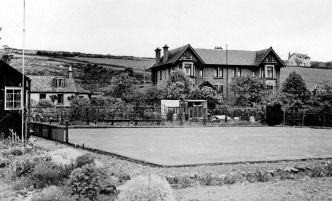
Bonhill Veterans Bowling Club (Click to Enlarge)
Ladyton farm can be seen on the hill in thebackground. This
is
where the Ladyton housing estate was built in the late 1960's
There seems to have been little appetite for team sports in Bonhill, nor for the formation of Sports Clubs. Apart from the Vale of Leven Golf Club, which was opened on its present site at Northfield in 1907, the Veterans Bowling Club which still flourishes in George Street, and the Quoiting Club which had its rink behind the Black Bull Hotel until the 1960's, Bonhill folk have joined clubs in other parts of the Vale. However, some Bonhill sportsmen competed at the highest level in both the 19th and 20th centuries.
First amongst them was a leading oarsmen of his time, Robert McAllister, the stroke man of a crew which became known as the “Callies” and which was one of the leading crews in Scotland from about 1848 to 1855. McAllister kept his crew's boat in his own boathouse at the Glebe in Bonhill and he also modified and built his own racing boats there. When his race winning days were over, he went on to become a full time builder of boats, firstly, at that boathouse and then as the firm of McAllisters, which is still a boatbuilder at Sandpoint Yard, Dumbarton.
James McLeavy, who was born in Bonhill in 1855, is amongst the best athletes that the Vale has ever produced. In 1873 while only 18 he won a mile race in 4 minutes 21 sec, which would probably still be a respectable time for a Scottish junior. In the same year his time in a 4-mile race was 19 minutes 52 seconds. Never mind modern training regimes and diets etc, given a tartan track and a pair of decent running shoes, he'd probably make the British team to-day without too much difficulty.
Lachie Stewart is, of course, his natural successor as the Vale's athlete of the 20th century. From his house on the Dalmonach Housing Estate, Lachie had easy 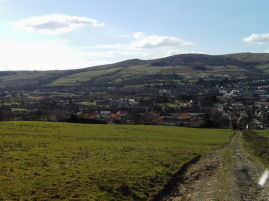 access to the hills above the Golf
Course as a cross-country training ground, as well as the steep hill of Auchincarroch Road. He was a member of the Vale Harriers who at that time trained at Millburn on the cinder track.
access to the hills above the Golf
Course as a cross-country training ground, as well as the steep hill of Auchincarroch Road. He was a member of the Vale Harriers who at that time trained at Millburn on the cinder track.
Many of the Harriers were reasonably successful in their own right at meetings across Scotland, but even the shorter distance runners found it difficult to keep pace with Lachie on his interval training 440 yards laps. His career's crowning moment was winning the 5,000 metres gold medal on the Meadowbank track at the 1970 Edinburgh Commonwealth Games in front of an ecstatic home crowd.
Anne Lang has been one of Scotland's most successful lady golfers in recent years being the Scottish Ladies Champion in 1996, 2003, 2004 and a member of the Curtis Cup team in 2004.
Although neither Ian McColl, captain of Rangers and Scotland nor Evan Williams, Celtic's goalkeeper in their second European Cup Final, were natives of Bonhill, both had businesses in the village when their playing days were over. McColl had a garage at the bottom of the brae, while Williams owned the Eagle Inn for many years until it closed and was demolished to make way for road re-alignment in the 1980's.
PAGE 1 | PAGE 2 | PAGE 4 | PAGE 5


